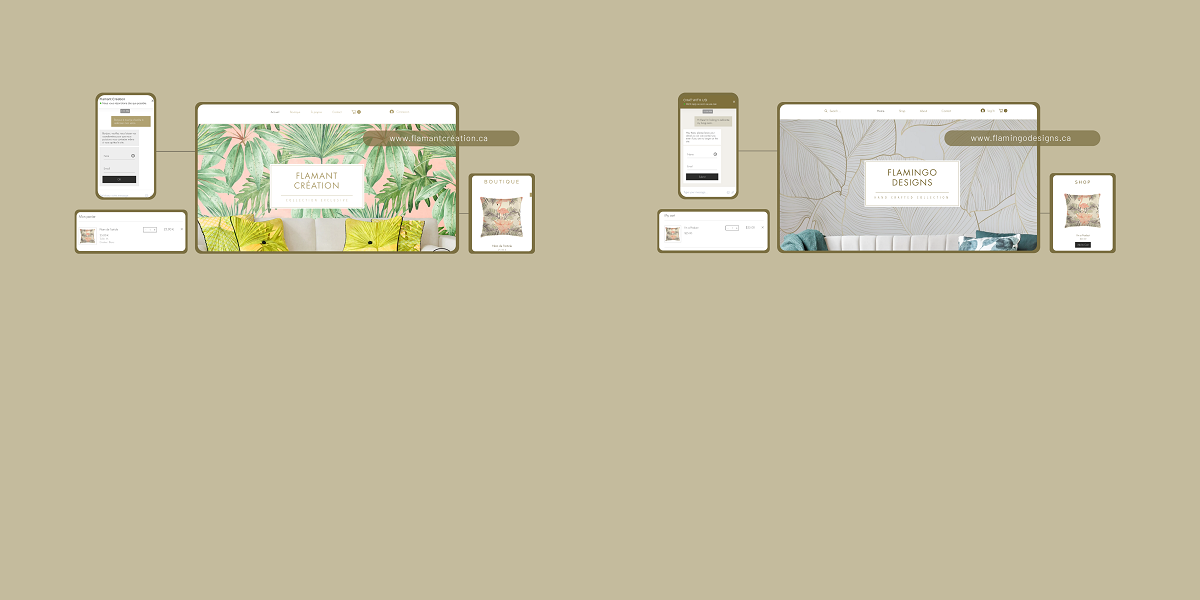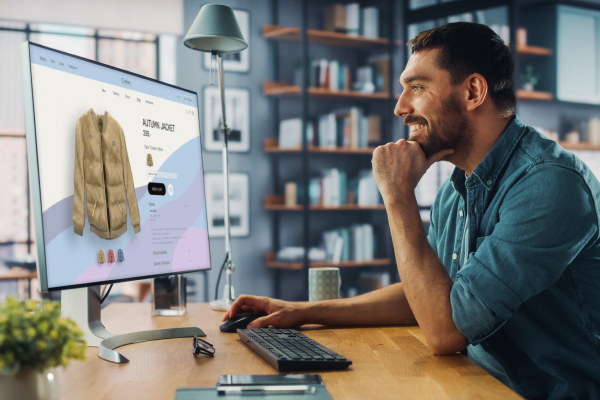
Retail ecommerce sales in Canada are expected to reach $94,139 million by 2027 – a trend that will continue growing exponentially. People can buy everything online now – from fresh groceries to prescription glasses – without ever leaving the comfort of their homes.
Investing in an online store can be a valuable addition to your revenue stream. The strength of ecommerce lies in its convenience as potential customers can find your business from anywhere with an internet connection. With an increasing number of Canadians shifting towards online shopping, your business can seize the opportunity to attract shoppers who are actively browsing the internet.
Before anything else, you need to lay the groundwork with some pre-launch preparation. The best way to start selling online involves a plan, similar to an overall business plan, specifically focused on ecommerce. It doesn't need to be complicated. However, it does need to outline the essentials for getting your online business up and running.
In this guide, we will cover:
- How to determine your primary customers
- How to be strategic in your product selection
- How to conduct competitor analysis
- How to manage your shipping costs
- How to determine the right return policy for online purchases
- How to shape your brand identity

Determine your primary customers
Now that you have decided to start selling online, it may be tempting to build your ecommerce website and list your entire inventory. There's a lot of planning that goes into running an ecommerce business, so don't rush into making your virtual storefront without determining your primary customers.
To create an ecommerce website that caters to your audience, identify your potential customers. Your primary customers are most likely ones who've already been consistently shopping at your brick-and-mortar store. By creating a customer profile based on their needs and wants, you can use your resources effectively to build a website that caters to their preferences.
To create a customer profile, start by looking into any relevant demographics. Consumers who consistently shop at your store often share similar characteristics, which will help fine-tune the flow of your ecommerce website. Although determining their age and gender is a starting point, delving deeper into their key needs and desires can distinguish your brand from competitors. Look into their specific buying patterns, shopping habits, and lifestyle preferences to paint a complete picture of your audience.
Tap into your existing resources to gather information about your customers. First, look at customer and inventory reports through your retail point-of-sale (POS) solution. The Moneris Retail Bundle has features like "Customer" and "Inventory." These allow you to monitor inventory levels and gather insights about customers' purchases and behaviours to find better ways to serve them. Not only will you be able to identify buying patterns, but you can also view your top-selling products.
Consider the products you want to sell online
Now that you have identified your primary audience, it's time to consider the products you want to sell online. Be strategic about your product selection to appeal to your primary audience. Choosing your niche is an essential step in running a profitable ecommerce store. Otherwise, you'll end up adding hundreds of products with no real focus!
If you sell a wide variety of products in-store, we recommend that you narrow your online inventory to only the best-selling items initially. You can update and upgrade your inventory as you learn more about your customers’ online buying habits. Look at your previous sales and inventory reports when choosing your online products. Also, consider going through your Google reviews, emails, direct messages and comments on social media to learn what customers are saying about your products.
Alternatively, you can gather valuable customer feedback by sending out surveys. Social media platforms can serve as effective tools for collecting information. For example, if your customers spend a lot of time on Instagram, then consider doing a poll or a quiz through your Instagram Stories. The information you collect will help you come up with your initial list of products to test with your audience.
Keep an eye on your competitors
Finding your competitive edge is as simple as researching your competition and comparing their ideas to your plan. To gather as much information as possible, be sure to:
- Review their website. Go through their entire ecommerce website and identify strengths and weaknesses. Take note of their photography, products, product descriptions, page layouts and the marketing messages on each page.
- Sign up for their newsletter. Analyzing competitors' newsletters can provide insight into their customer communication strategy. Consider the type of content they share, the frequency, and where the email journey takes you.
- Check out their blog. See how often they post online and the type of topics they cover. Analyzing their blog posts can provide insight into their marketing and branding strategies, which you can then leverage to improve your own brand.
- Follow them on social media. Go through their comment section to see their responses to positive and negative customer feedback. Note any recurring customer complaints about their products or shipping, as this may give you a competitive edge.
- Put an item in your cart and abandon the checkout process. Monitor whether or not they send an abandoned cart email and how they communicate with potential customers.
- Peek at pricing. Be sure to look at prices across all their channels to learn what your target audience is willing to pay. Don't ignore the total cost, which includes taxes and shipping fees.
- Purchase a product. Check out the product itself, the packaging, shipping time, and how they notify you throughout the process.
- By analyzing your competition, you may find opportunities for how to position yourself against or alongside them.

Start thinking about shipping
High shipping costs are the number one reason customers abandon their purchases online. Did you know that 69.82% of shoppers abandon their carts if the cost of delivery turns out to be higher than expected? Go with a flat rate on shipping, as well as offer free or discounted shipping for customers who spend a certain amount of money. Customers are more likely to buy more products just to get to that free shipping threshold. While delivering products may seem like an easy task, you could end up with higher costs and unhappy customers if you don't consider the following variables. To make things easier, try considering an ecommerce platform with shipping integrations.
Packaging
Your choice of packaging is an extension of your product and customer service. Besides timely delivery, you will need to consider the fragility, size and weight of your products. There are numerous types of box sizes, packing materials, padded mailers and labels that may be suitable for your business. Many companies choose the option of carrying a handful of standard packaging sizes to streamline and simplify costs for both them and their customers.
Delivery
Deciding on supplies and packing materials is only half the job. The remaining shipping decisions focus on the actual transit of your products. Here, again, many variables affect transportation, including the size and weight of the package, tracking and insurance.
Test the buying process
Whatever you decide, be sure to order a product from your ecommerce website. Take note of the delivery time, the quality of the purchased item, and the condition and look of the package upon receipt. These factors can largely influence how customers perceive your brand and their overall experience.
How to reduce abandoned carts
If you can't afford to set competitive shipping prices at the start, here are some ways to set yourself up for success.
Create a page on your ecommerce website that explains your shipping process. Display shipping fees, taxes and other expenses here for your customers to see.
Offer free or discounted shipping for customers who spend above a certain amount.
Go the extra step by offering a coupon code or promo card with every order.
Consider doing giveaways on social media or adding a "surprise and delight" element.
Each business is unique, so you'll need to customize the various options to your business model. It may also require you to make changes down the road to more efficient shipping methods. Just remember: a well-packaged product that arrives safely will communicate your level of commitment to both the product itself and the customer's satisfaction.
Determine the right return policy for online purchases
Having an efficient refund policy is a crucial factor in establishing customer loyalty. If customers perceive that returning a product to your store is a cumbersome process, they may hesitate to make a purchase from your ecommerce website. Or, if they do place an order and get frustrated with your return policy, you may find that they resolve their frustrations with a chargeback.
A well-thought-out return policy should balance the customer's need for satisfaction and your bottom line. When designing your return policy, keep the following elements in mind:
Time frame. Typical return policies for retail businesses range from 14-30 days. However, if you sell food with best before dates, makeup with sanitation concerns, or seasonal apparel, you may want to consider a return policy that reflects those factors.
Proof-of-purchase. Not only can a receipt confirm that the product is from your store, but it informs you of the date of purchase and the price at the time of sale.
Proper packaging. Some products, like cosmetics and electronics, will need to be used before the customer knows if they are satisfied or not. It will go a long way with customers to ensure that your return policy is reasonable and in line with what you sell.
Make sure your brick-and-mortar refund policy is reflected online. Create a webpage that highlights your shipping and return policies, as well as answers to frequently asked questions regarding their orders. You should also list options for exchange or store credit. Most retailers offer merchandise credit on a gift card if the customer has passed a specific return time frame.

Consider your brand identity
The last step in preparing for your ecommerce website is determining how to redirect focus to your online presence. With up to 14 hours of web creation support with Moneris Online your website can be created for free*. Consider your target customers, the way they will interact with your business online, and what type of experience you want them to have on your ecommerce website.
First, you need to pick a domain name where people can easily find you in the digital space. Try to stick with your current brand name and capitalize on the brand awareness you've already developed with your brick-and-mortar business.
Establishing an online presence for your business
Selling online doesn't need to be a daunting task. Many easy-to-use options allow you to customize your ecommerce website to match your brand.
Your ecommerce website might be another point of contact that loyal customers have with your brand, but it can also help you reach new customers. There is a lot of thought that goes into launching your online store. To make sure you're using your resources carefully, remember the following tips:
- Define your primary audience by building a customer profile. Tap into the buying habits and shopping patterns of your current customers to create a robust profile.
- Review your sales and inventory reports to determine your top-selling products.
- Be thorough with your competitor research to identify new opportunities for positioning your business.
- Be upfront with your shipping and return policies, so customers know what to expect.
- Make sure your website represents your current brick-and-mortar business that your customers already know and love.
Before you start building an ecommerce website, discover the different types of ecommerce solutions, what they should offer, and if your current solution checks all these boxes.
Another important feature you must incorporate on your website is online payment processing. With a wide range of payment options, security and fraud prevention, a user-friendly interface, 24/7 bilingual customer support and more, Moneris Online can help your business streamline payment processing activities and increase revenue. Click here to learn more.
Author Profile
Niyati Budhiraja
Author Profile
Niyati Budhiraja is a word nerd who turns tricky business talk into fun, simple and genuinely helpful content. She writes features on inspiring Canadian businesses, crafts easy-to-follow guides and shares smart tips to help small businesses feel confident and supported. When she’s not writing or dreaming up her next blog idea, you’ll likely find her hunting down the city’s best hot chocolate.









